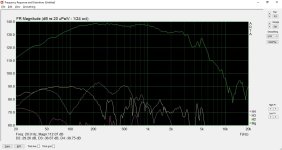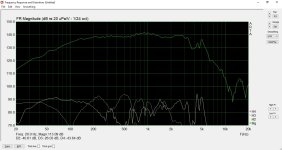Do drivers with a flatter impedance necessarily have less EMF induced non-linearity? For example a planar magnetic driver.
Certianly when a driver has a copper sleeve known to reduce eddy currents we also see a reduction of the inductive curve.
Certianly when a driver has a copper sleeve known to reduce eddy currents we also see a reduction of the inductive curve.
I've built many speakers using from cheap to high end drivers. I didn't know that additional output impedance can have this benefit. I've read about it, but we read a lot of things that are not true!Hi, you are right, in general, better drivers get less benefit, while poor (motor) drivers more. Also, only some motor related problems get helped. If all motor issued were fixed, even still at some point some other distortion mechanisms start to dominate, like suspension.
Distortion wpuld reduce by reducing excursion as well, so effective distortion reduction mechanism is highpass filter, and likely electrical damping at the main resonance as well if it prevents un-necessary excursion, from xternal sources for example.
Although, it's quite complicated stuff as per in this very thread, jump resonance stuff and all. Everything depends 🙂 Use good system design, best driver, and perhaps try some impedance manipulation. In the end, distortion doesn't seem to be much of a problem.
It seems kind of like there is some extra cake remaining on the table that nobody eats. Now we have so many DSP speakers it seems easy to grab that cake 🎂
Show your measurements! Nobody cares about what you heard or think you saw.I have experimented with distortion measurements
Please!
Show your measurements! Nobody cares about what you heard or think you sawin general
Please!
Find the cake with your own measurements ;-)some extra cake
Did you do a real 2-channel measurement, or was the amplifier part of the device being measured?
I could only find this, comparing a 18sound 8" with and without 1mH coil. No EQ applied, but the level was adjusted to have a similar SPL in the 2k region. You can see the distortion is lower even if the output is on a similar level. You can also see that above 1k H3 is reduced relative to H2. SPL scale is not calibrated, and it's measured with mic close to the driver to get better SNR.
This is not what I usually look at (prefer multitone), but it's all I happen to have saved. I'm not good at documenting stuff, and I had a USB stick with all my projects on it that got destroyed, so I lost a lot of measurements.
This is not what I usually look at (prefer multitone), but it's all I happen to have saved. I'm not good at documenting stuff, and I had a USB stick with all my projects on it that got destroyed, so I lost a lot of measurements.
Attachments
That is a good start. Your measurements remind me of the unbearable pain staring at my Farina sweeps over a year ago. You have ARTA and the other stuff one needs - to take (ARTA) STEPS measurements? Did you read #170 above?I could only find this
Did you already find the: "LRDDMC" ?
https://www.diyaudio.com/community/...on-measurement-challenge.407527/#post-7560023
Now we have so many DSP speakers it seems easy to grab that cake
Nobody cares about what you heard or think you saw
Did you understand my question?
Find the cake with your own measurements ;-)
Did you do a real 2-channel measurement, or was the amplifier part of the device being measured?
It was a single-channel measurement. The amplifier is LM4780, distortion is well below the level of the ND91-4 driver.
If I used a reference channel after the EQ unit, the EQ would be subtracted from the measurement, which is not helpful.
Later I might try with some more drivers like midrange and tweeter.
If I used a reference channel after the EQ unit, the EQ would be subtracted from the measurement, which is not helpful.
Later I might try with some more drivers like midrange and tweeter.
Interesting thread. I just found it only now. Is the OP saying that adding a high impedance 20ohm resistor in series will reduce distortion in the speaker?
This has some practical issues: kills speaker sensitivity, especially in bass, kills amp DF and ability to get snappy hard hitting bass, and limits ultimate power you can play.
Or was this to simply show that if you make it a current amp, the distortion is reduced?
I have a real hard time understanding what the traces represent in the plots. They should have a legend or a label added.
Doesn’t anyone use REW on this thread? Legends are automatic if you name the measurement in its label box.
This has some practical issues: kills speaker sensitivity, especially in bass, kills amp DF and ability to get snappy hard hitting bass, and limits ultimate power you can play.
Or was this to simply show that if you make it a current amp, the distortion is reduced?
I have a real hard time understanding what the traces represent in the plots. They should have a legend or a label added.
Doesn’t anyone use REW on this thread? Legends are automatic if you name the measurement in its label box.
This brings back memories. I really >really !!< do not want to diminish your beloved LM4780. My beloved Hypex UcD34MP that i love like a mad man until today for its minute mains power consumption, does distort with constant 0,15% in the whole frequency band. Not to mention my beloved other amp, which distorts less at 1kHz, but distorts "badly" with the harmonics all over the place in the "rest" of the range.It was a single-channel measurement. The amplifier is LM4780, distortion is well below the level of the ND91-4 driver.
If I used a reference channel after the EQ unit, the EQ would be subtracted from the measurement, which is not helpful.
Later I might try with some more drivers like midrange and tweeter.
The result was the most stupid expense i ever did: buying an amp with a SINAD 100. Just to follow the EQ dictate which dictates being able to perform measurements with only 1Ch.
Just weeks later i realized the EQ dictate is just a stupid distraction from the superiority of "resistor-drive ("current-drive"). One of the successes of the happy camping parrots. The other is the "current drive amplifier".
So please do yourself (and me ;-) a favor: ditch the EQ just for one 2Ch measurement. Just one hurdle to take: I strongly recommend to build an use an antiparallel diode limiter to keep your 2i2 safe. For inspiration see (#3) or ARTA appnote measuring box.
With 20R at 4R nominal transducer you should see more than 8dB (1% to 0.4%) reduction in D3
Last edited:
So you may participate in LRDDMC with nice labels?Doesn’t anyone use REW on this thread?
As far as i know this is an audio magazine myth that cannot be proven. The "fast" and hard bass guitar or synth attack will be played back by tweeter and/or midrange.ability to get snappy hard hitting bass
I’m talking about amp damping factor / amp output impedance. Low impedance simply has more voice coil actuator authority. There’s no hocus pocus / myth there.
Current drive is like everything else in audio, it has it pros and cons. Rod Elliot has two excellent articles on explaining current drive principles and implementation:
https://www.sound-au.com/articles/current-drive.htm
https://www.sound-au.com/project56.htm
I’ll end this post with this a quote from Rod:
“I've been using current drive in various forms since the early 1970s, with typical output impedances of up to 200 ohms. Over the years many people have heard what they initially thought were huge improvements in the sound of individual drivers and/or complete systems. In reality, only some effects were ultimately found to be useful, and almost identical results can often be achieved with fairly basic equalisation.”
https://www.sound-au.com/articles/current-drive.htm
https://www.sound-au.com/project56.htm
I’ll end this post with this a quote from Rod:
“I've been using current drive in various forms since the early 1970s, with typical output impedances of up to 200 ohms. Over the years many people have heard what they initially thought were huge improvements in the sound of individual drivers and/or complete systems. In reality, only some effects were ultimately found to be useful, and almost identical results can often be achieved with fairly basic equalisation.”
Show your measurements! Nobody cares about what you heard or think you sawis like
Well now that is an interesting point! I'm only just in on this, but as voice coil motion is a direct result of current, not voltage, in fact the high impedance output that dictates current provides more linear control of the voice coil. That's why we see a reduction in distortion products that would otherwise be caused by instantaneous impedance changes (emf).I’m talking about amp damping factor / amp output impedance. Low impedance simply has more voice coil actuator authority. There’s no hocus pocus / myth there.
What we do see with high impedance current drive is a counter-action of the speaker drivers impedance so that an equal current is delivered regardless of a resonant peak. Thankfully this is a 'mi imum phase' resonance meaning it obays the same principles as electronic resonances and can be controlled by 'IIR' eq in both amplitude and decay.
This sounds very unfriendly like a demand. It might be a mother language difference, but continued posts like this will turn away interested people.Show your measurements! Nobody cares about what you heard or think you saw
I have measured the amplifier separately, distortion and noise is below 0.01%.This brings back memories. I really >really !!< do not want to diminish your beloved LM4780. My beloved Hypex UcD34MP that i love like a mad man until today for its minute mains power consumption, does distort with constant 0,15% in the whole frequency band. Not to mention my beloved other amp, which distorts less at 1kHz, but distorts "badly" with the harmonics all over the place in the "rest" of the range.
The result was the most stupid expense i ever did: buying an amp with a SINAD 100. Just to follow the EQ dictate which dictates being able to perform measurements with only 1Ch.
Just weeks later i realized the EQ dictate is just a stupid distraction from the superiority of "resistor-drive ("current-drive"). One of the successes of the happy camping parrots. The other is the "current drive amplifier".
So please do yourself (and me ;-) a favor: ditch the EQ just for one 2Ch measurement. Just one hurdle to take: I strongly recommend to build an use an antiparallel diode limiter to keep your 2i2 safe. For inspiration see (#3) or ARTA appnote measuring box.
With 20R at 4R nominal transducer you should see more than 8dB (1% to 0.4%) reduction in D3
What amplifier did you choose with 100dB sinad?
Last edited:
- Home
- Loudspeakers
- Multi-Way
- Drive Current Distortion Measurement

